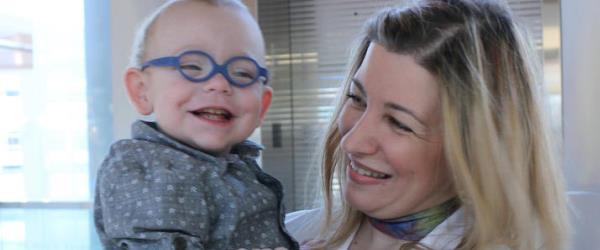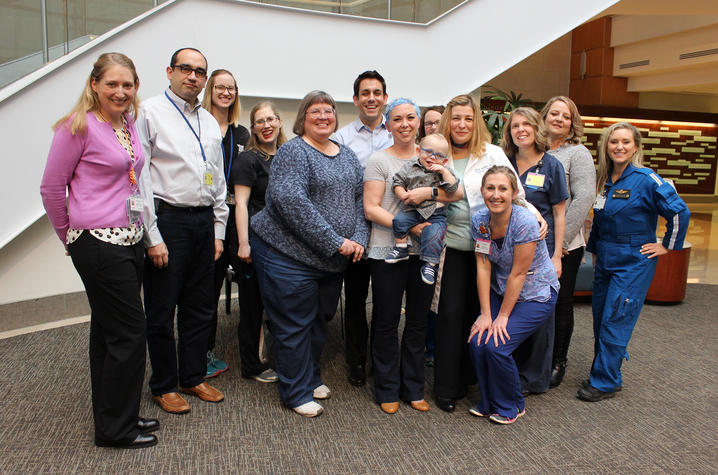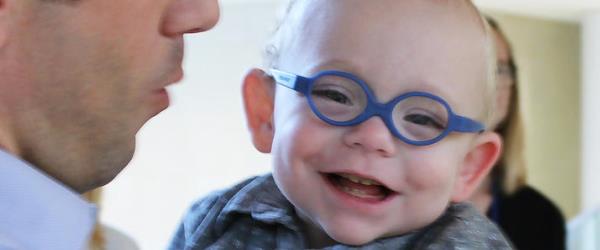Pediatric surgeon tells little Connor’s story of hope


Written by Dr. Ana Ruzic, a pediatric surgeon at Kentucky Children’s Hospital.
Let me tell you a true story of hope. It may be difficult to read, but I promise you nowhere as difficult as being its main character. This is Connor’s story.
Nearly one year ago, Connor Stacy went home from the Kentucky Children’s Hospital Neonatal Intensive Care Unit, or NICU, snuggled in his mom’s arms, too small to fit in his elf hat but nearly three times as big as the day he was born. Just recently, his mom sent me a photo of Connor wearing that famous hat. He is getting close to walking and speaking. To anyone who took care of him in his six-month NICU stay, he is the definition of hope.
A premature birth, then more complications
I met Connor and his family in August 2015. They had already lived through a hailstorm of trauma, experiencing a premature birth and the subsequent marathon of the neonatal ICU.
For a NICU family, meeting a surgeon is never an easy feat. While some of these consults involve more benign needs, such as reliable IV access or an expected hernia that can wait for a repair, all too often they indicate a need for an emergent operation. Along with our neonatologists, my three surgery colleagues and I carry the privilege and the burden of meeting NICU families on a sudden, unexpected and very bad day. And on the day I met him, Connor went from well to critically ill in a matter of hours.
In the morning, he was eating and growing, and by the early afternoon, he was in advanced stages of necrotizing enterocolitis (NEC), a severe intestinal infection often seen in premature neonates. By the early evening, he was in multi-system organ failure. More than half of babies with NEC do not make it, despite aggressive management and all the advancements of modern medicine.
Treatment for Connor
Our first step was to remove the damaged portions of Connor’s small intestine. Connor weighed only 1,200 grams and was so fragile we could not move him to the operating room. Instead, we did the operation in the NICU. In the course of the following five days, he underwent three major operations. And somewhere in the midst of it all, his kidneys stopped making urine.
When the kidneys fail, the body fills up with toxins and fluid and their function is replaced by dialysis. The dialysis continues until the renal function recovers or further treatment becomes futile. Futility is the antithesis of hope, but we have the responsibility to our families, our patients and each other to recognize that point of no return.
I didn’t know if we would reach that with Connor, other than to tell his parents we would “keep going until we were no longer doing treatments for him, but to him.” That is not my quote, by the way. It was taught to me by Dr. Joseph Iocono, some years ago when I was his resident. He is now my boss, my colleague and my mentor.
Thinking outside the box
Connor needed dialysis, but unfortunately, we don’t have a great way to dialyze 1,200-gram babies. With Connor, our care team had to improvise, think outside of the box and believe in something far greater than each of us individually: science, divinity, neither or both. Above all, we had to rely on faith in each other.
As joined as we are by this story, we are all different in the ways we approach medicine and patient care. We are guided by our own stories, each as different as the next. We do not always agree and that is exactly what Connor needed – for us to challenge one another, our biases and our previous outcomes. This is also the story of true multidisciplinary medicine, which takes the impossible and makes it the standard of care.
With the help of Dr. Aftab Chishti and Dr. John Draus, we devised an inventive technique to sustain Connor’s life by providing manual dialysis for Connor for two weeks until his renal function spontaneously recovered.
Connor’s team
In those two weeks Crystal, Mary, Becca, Kim, Lindsey, and a number of other nurses performed manual dialysis every 15-30 minutes for 12-hour shifts at the time.

And while the physicians came and went, Genine and Heather, Connor’s neonatal nurse practitioners, kept the care consistent and in order for the rest of us. For months to follow, Genine and Heather encouraged Connor’s family, nursed his wounds, protected his development, loved him and bonded with him the way only mothers do, before having to let him go. This is their story, as much as it is Connor’s.

By the time he was discharged home, Connor crossed paths with 11 neonatologists, four pediatric surgeons, 15 neonatal nurse practitioners and PAs, two nephrologists, nine surgery residents, and an array of respiratory, music, speech, occupational and physical therapists, each an essential piece of his puzzle.
I cannot begin to touch on the village it took to get him home. Nor can I begin to describe the dignity, compassion and kindness with which his parents, Chrissy and Dustin, graced each of us, despite living through a battle none of us will ever completely appreciate – that of a NICU parent. This, above all, is their story.
Those of us who take care of neonates carry within us a healthy dose of realism, which we drown with cautious optimism every time we walk into the hospital. Hope is that intangible quality of pediatric physicians, in whose shadow we walk each and every day, careful not to share it too much or risk losing credibility. We hold it close nonetheless. It is our guiding light, held brighter by the courage of our little patients and their families, breathing life in the very walls that surround our children’s hospital.






